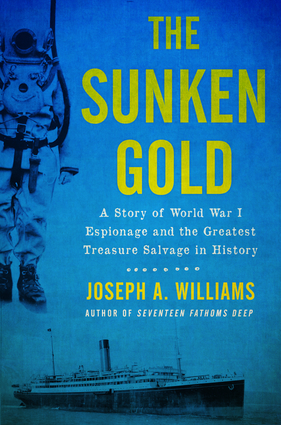Overview
On January 25, 1917, the HMS Laurentic struck German mines off the coast of Ireland and sank. Its shipment was critical: Britain at that time was facing escalated submarine warfare, which had been sinking millions of tons of cargo and threatening the country with starvation. The Laurentic was carrying 44 tons of gold bullion to the still-neutral United States via Canada in order to finance the war effort for Britain and its allies. The salvage mission was confidential, since the British government dared not alert the Germans to the presence of the sunken treasure. Lieutenant Commander Guybon C. C. Damant was the most qualified officer to head the mission—he personally set a deep sea diving record in 1906 and had worked to establish safer deep sea diving procedures.
Though Damant’s salvage team was successful at first, and recovered a significant amount of gold, wild gales battered the wreck into the shape of an accordion, turning the operation into a multiyear struggle of man versus nature. Damant was called off the salvage when his skill became needed to lead a team of covert divers to investigate and search through the contents of recently sunk U-boats for ciphers, minefield schematics, and other secret documents. The information they obtained, once in the hands of British intelligence, proved critical toward Allied efforts to defeat the U-boats and win the war.
At the conclusion of the war, Damant had become obsessed with completing his long-deferred mission. His team struggled for five more years as it became apparent that the work could only be accomplished by muscle, grit, and persistence. In the end, Damant and his team recovered 99 percent of the gold with no significant injuries to the men. His deed became one of the most notable exploits in the annals of undersea diving and naval operations, and the Laurentic became a model for later salvages. More than an incredible story about undersea diving adventure, The Sunken Gold is a story of human persistence, bravery, and patriotism.
Reviews
“Joseph A. Williams makes history come alive in his latest book, as though the readers are standing on the slanting decks of the sinking Laurentic. His thorough investigation into the aftermath that leads to the recovery of gold deals with all the behind-the-scenes politics and advances in technology at that point in history. This book is a valuable resource on many fronts.” —Michael Poirier, coauthor of Into the Danger Zone: Sea Crossings of the First World War
“Joseph A. Williams has uncovered one of the greatest stories of World War I, a tale of U-boats, lost treasure, and the tenacious diver determined to recover it at all costs. Simply put, this book is a real gem.” —James M. Scott, 2016 Pulitzer Prize finalist for Target Tokyo: Jimmy Doolittle and the Raid That Avenged Pearl Harbor
“A wild and wooly tale of pressurized goats, black arts, and maritime gold, all beautifully told. Williams has a real gift for fleshing out the human story from arcane historical facts. I was taken by the whole thing, and devoured the whole of it in two thrill-filled nights.” —James Nestor, author of Deep: Freediving, Renegade Science, and What the Ocean Tells Us About Ourselves
“A fascinating, meticulously researched, historical adventure of gold salvaged under impending doom of War and Wind.” —Bernie Chowdhury, author of The Last Dive
“A well-told tale of naval exploits in which gold is the MacGuffin.” —Kirkus Reviews
“…recounts an American naval officer’s obsessive quest to recover 44 tons of gold from a sunken ship off the coast of Ireland during WWI.”—Publishers Weekly
"The Sunken Gold is a masterclass in how to research a subject and write about it.” —Underwater Contractor International
"It's also a story of human persistence and bravery, showcasing the lives of men that pushed every boundary of body and science in their resolute refusal to be denied."—American Digger Magazine
Author Biography
Joseph A. Williams is the deputy director of the Greenwich (CT) Public Library and the author of Seventeen Fathoms Deep: The Saga of the Submarine S-4 Disaster and Four Years Before the Mast: A History of New York’s Maritime College. He lives in Harrison, New York.
 Mother's Day
Mother's Day Father's Day
Father's Day
